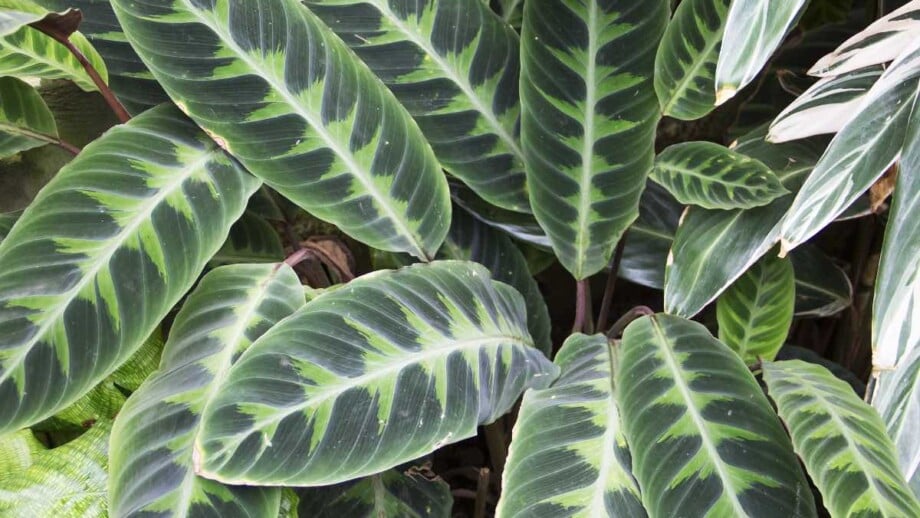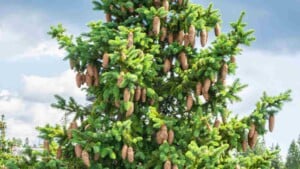Calathea houseplants are known for their foliage which has captivating patterns and is bound to make anyone pause and take notice. These stunning pieces will add a splash of color and texture to any room in your house.
Even the undersides of the leaves offer aesthetic appeal, as they may display a vibrant splash of color during the evening.
It can be hard to figure out how to take care of these tropical plants at first. But read this guide to learn exactly what to do and once you start to properly care for your calathea plant, you’ll be rewarded with vibrant colors and the delicate motion of the leaves.
Botanical Name: Calathea
Common Name: Calathea, zebra plant, prayer plant, rattlesnake plant, peacock plant, beauty plant, cathedral plant
Family: Marantaceae
Plant Type: Herbaceous, perennial
Hardiness Zones:11 – 12 (USDA)
Sun Exposure: Partial, shade
Soil Type: Loamy, moist, well-drained
Soil pH: Acidic, neutral
Height: Up to 2 ft
Bloom Time: Spring, summer
Flower Colors: Purple, white, yellow
Quick Guide: Planting, Growing & Caring for Calathea
- Growing and caring for calathea can be tricky, but with the right information you can easily take care of them
- Calathea is a tropical plant that prefers warm, humid conditions with bright indirect light
- The type of water matters for this plant as it is sensitive to minerals and compounds in tap water
- Fungus gnats, aphids, spider mites, scale, and mealybugs are some of the most common pests to watch out for
Calathea Plant Care
Calatheas are often known as prayer plants. This name comes from how these indoor plants move, called nyctinasty. The leaves move throughout the day. It is believed that this movement enables the plant to make the most of its exposure to light.
During the night, the leaves will fold inward so that the front or face of the leaves are pressed together, but during the day, the leaves will fall back so that they may absorb light.
Calathea care can be hard because the plants need certain conditions and don’t do well when they are neglected. However, they are most successful when grown outside in their natural tropical environment, and if you can replicate that environment inside, they’ll do incredibly well.
It’s not hard to see why calatheas are often thought of as plants that thrive in greenhouses. They are very sensitive to cold temperatures and thrive in the warm, humid atmosphere that greenhouses often offer. However, you may get a similar effect in your home.
Light
Calatheas like filtered light or shade, which seems strange for a tropical plant. They’re used to momentary dapples of sunshine instead of persistent harsh rays since they grow under a forest canopy.
Therefore, make sure that your calathea is kept out of direct sunlight, since prolonged exposure to this kind of light may cause the leaves to burn and the bright patterns on them to become less noticeable.
If you want to grow them indoors, medium to bright indirect light from a window facing east, south, or west should be enough. They can handle low light as well, but brighter light helps them maintain their bright, vivid colors and patterns.
Soil
For best results, grow calantheas in organically rich, loamy soil. The optimal pH range for soil is slightly acidic to neutral.
They prefer potting soil or mix that’s well-draining. For that, look for potting soil with ingredients such as perlite, worm castings, coco coir, pine bark, or compost.
A peat-based potting combination that is lightweight and airy works well for potted plants as well. Another option is to use any specialty mix that is designed specifically for African violets.
Water
Water on a regular basis to keep the soil wet (but not saturated). While calatheas like a steady supply of moisture and water, they prefer to avoid standing water or being waterlogged.
When watering calathea, it’s important to consider the type of water you use. Tap water may include minerals or substances that are harmful to the leaves.
If the leaves begin to turn brown at the tips, it may be a sign that the water is too salty or includes chemicals like chlorine, chloramine, bromide, or fluoride.
If you have reason to believe that tap water is not good for your calathea, you may want to consider watering the plant with filtered or distilled water, or water collected from a dehumidifier.
Temperature and Humidity
Calathea plants flourish in temperatures between 70 and 85 degrees Fahrenheit. They can handle temperatures as low as 60 degrees Fahrenheit, but not lower.
Also, calathea plants do best with 50% or more humidity. Place a humidifier near your plant inside to make the air around it more moist.
You might alternatively set the pot containing the plant on top of a tray that has water and stones in it. If you do this, be sure that the water does not touch the bottom of the pot.
Additionally, terrariums are a fantastic alternative for producing humid conditions; all you would need to do is locate one that is big enough to accommodate the sprawling leaves of a calathea.
Fertilizer
Follow package recommendations to fertilize your calathea monthly with a half-strength liquid balanced fertilizer in spring, summer, and fall for a lush, full plant. It’s best to hold off on fertilizer application throughout the winter, when plant growth is slower.
Pruning
Calathea plants do not need to be pruned regularly. You will only need to remove discolored, wilted leaves when they die off naturally. And this is only to maintain the plant looking neat since the leaves will eventually fall off on their own.
Overwintering
Calathea houseplants may be brought outdoors in summer if nighttime temperatures are above 60 degrees Fahrenheit. Additionally, the humidity in your environment must range from moderate to high.
However, as soon as the temperature begins to drop below sixty degrees, it is time to bring your plant back inside. But first, look at the leaves and the pot to see if there are any garden pests. They may be eliminated with a hose-end spray of water, or you may need to apply insecticidal soap. Then, bring your plant back inside and keep doing what you were doing to raise humidity.
Types of Calathea
There are several dozen calathea species. Here are some of the most popular ones:
- Calathea makoyana: This variety is also known as peacock plant since it features dark green, purple, cream, and pink leaves with red stems.
- Calathea roseopicta ‘Dottie’: This is a darker variety of calathea featuring deep green burgundy leaves that have a pink hashed border and a pink stroke in the center. The undersides have a vibrant deep red-purple color.
- Calathea lancifolia: This specie is also known as rattlesnake plant. The leaves are long and slender, with ruffled edges that are unique to this Calathea species. They are brilliant green with dark green patterns that go down each leaf with purple undersides.
- Calathea veitchiana: This specie is also known as Calathea medallion because of its medallion-like leaves. It features a beautiful green pattern on top with a deep burgundy underneath
- Calathea orbifolia: This is one of the largest calathea species featuring oversized green leaves with silver stripes.
- Calathea ornata: The pink stripes on the deep green leaves of this species are what give it the name pinstripe plant.






How to Plant and Grow Calathea
How to Grow Calathea from Seed
When it comes to growing calatheas, nursery plants are the most popular choice. The likelihood of success when starting them from seeds varies.
But given that seeds are often affordable, it’s worth a shot if you’re trying to save some money. The optimal time to plant seeds is in early spring. Here’s how it’s done:
To grow calatheas grow seeds, start by filling seed-starting mix into small containers or a seed tray. Make sure that any container you use has plenty of holes for drainage. Then lightly moisten the mix with water.
Press the seeds into the mixture slightly, and then place the container in a warm, bright, indirect light area and cover it with transparent plastic wrap to lock in the moisture.
Continue to keep the soil mildly moist but never saturated. Germination should occur in two to four weeks.
How to Propagate Calathea
Calathea propagation is a cheap method to obtain new plants and allows you to multiply plants with particularly attractive coloring and patterns.
Calathea grows quickly in the spring and summer, so this is the best time to propagate it. Root division is the most effective method of calathea propagation, however it should only be used on healthy, two-year-old parent plants.
You should water your plant the day before you plan to split it up so that the roots can soak up enough water before being propagated.
To do this, carefully dig up the plant without hurting its roots. Then split the plant into two halves, by slowly separating the roots. A garden fork may help you separate difficult roots.
Replant the fresh parts at the same depth as before in their new growing spots. Water to keep the soil moist.
How to Pot and Repot Calathea
A calathea plant will do well in a pot that is between 8 and 10 inches wide and has a depth of at least 8 inches. Make sure there are plenty of drainage holes.
If you tend to overwater your plants, unglazed clay is a suitable material since it lets soil moisture escape through its walls.
One calathea plant per pot prevents root overcrowding. Make it a habit to repot the plant every few years in a container that is 1 to 2 inches wider in diameter than the previous one.
If a Calathea plant becomes root-bound, it will be unable to absorb water and nutrients as effectively, leading to the plant becoming weak and unhealthy.
The best time to repot a plant is in the spring or early summer when it is growing the most. Be sure to give your calathea plenty of water a day or two before repotting to help reduce the stress on the plant.
Pull the rootball out of the old pot gently, trying to keep as many of the roots together as possible. Plant it at the same depth in the next container, surrounded by fresh potting mix.
Common Pests and Plant Diseases for Calathea
As calathea plants love moist conditions, they are vulnerable to fungus gnats, which flourish when there is moisture. They often have little effect on the plant’s health and may be eliminated using neem oil.
Apart from fungus gnats, aphids, mealybugs, spider mites, and scale are other common pests for calathea. Many of these problems may be resolved by repeatedly applying insecticidal soap or horticultural oil.
You can also click on any of the clicks above for guides on the particular pest you are dealing with to learn exactly how to get rid of them.
Other House Plant Guides from Planet Natural:
How to Plant, Grow, and Care for Alocasia (Elephant’s Ear)
FULL GUIDE: White Bird of Paradise Care (Strelitzia Nicolai) + FAQ
ULTIMATE GUIDE to Stephania Erecta Care from Dormancy to Sprouting – All You Need to Know!











